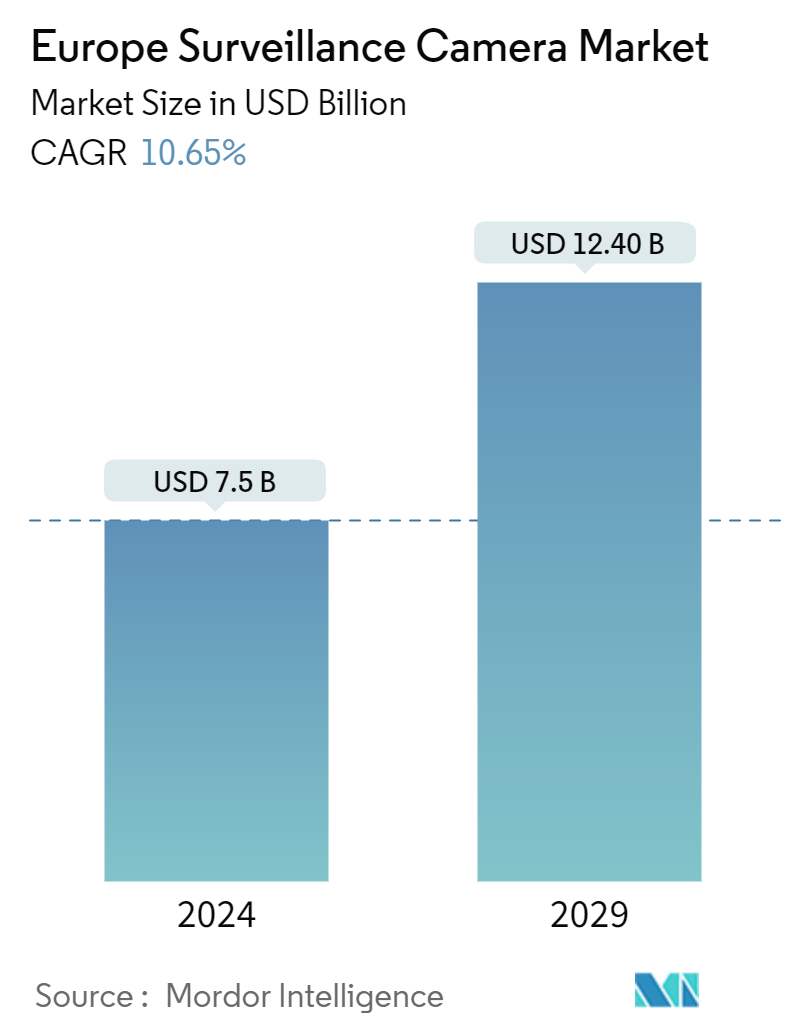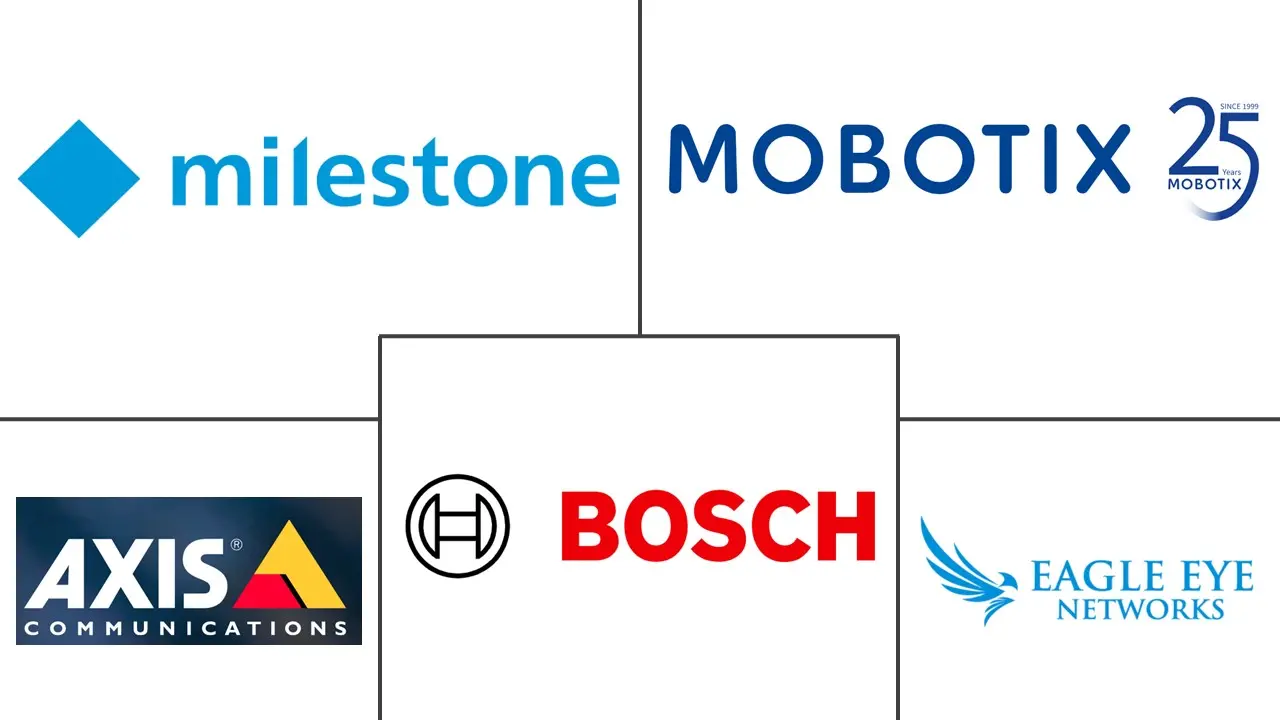Market Size of Europe Surveillance Camera Industry

| Study Period | 2019 - 2029 |
| Base Year For Estimation | 2023 |
| Market Size (2024) | USD 7.5 Billion |
| Market Size (2029) | USD 12.40 Billion |
| CAGR (2024 - 2029) | 10.65 % |
| Market Concentration | Low |
Major Players
*Disclaimer: Major Players sorted in no particular order |
Europe Surveillance Camera Market Analysis
The Europe Surveillance Camera Market size is estimated at USD 7.5 billion in 2024, and is expected to reach USD 12.40 billion by 2029, growing at a CAGR of 10.65% during the forecast period (2024-2029).
Surveillance cameras are an essential part of today's society. They play an important role in preserving security and monitoring public areas. The number of surveillance cameras is constantly increasing in Europe. Digital technology and the internet have entirely transformed the surveillance industry. IP cameras, capable of transmitting video over computer networks, are becoming popular due to their flexibility and ease of installation. Surveillance cameras have become increasingly commonplace in public areas, such as educational institutions, retail stores, airports, and residential areas. Facial recognition technology has further advanced the surveillance system's ability to identify and monitor individuals more effectively.
Artificial intelligence (AI) and facial recognition have made surveillance cameras even more advanced, allowing for more advanced monitoring and analysis. The rise of terrorism and public safety concerns in Europe have increased the demand for surveillance cameras in public areas. For instance, in March 2023, the French National Assembly approved the implementation of AI video surveillance for the 2024 Paris Olympic Games. According to the French government, AI video surveillance can identify pre-defined events, abnormal behavior, and crowd surges, thus safeguarding the security of millions of tourists expected to visit the French capital during the summer of 2024.
The increasing capability of surveillance cameras owing to recent technological developments is also expanding the use cases of these cameras, thereby encouraging consumers across various industries to adopt these solutions. For instance, in June 2023, Monitoreal and Redimport partnered to provide perimeter security services in Belgium. Montreal has developed video analytics appliances and accessories that enable users to observe their environment in real-time. This factor triggers customizable alerts when people, vehicles, and objects are in the most critical areas. Furthermore, these systems can prevent intruders from entering the premises by starting intelligent audio and light devices based on relevant detections.
The increasing instances of burglaries and robberies across various European countries create a favorable outlook for the market's growth. Surveillance cameras help residents and law enforcement quickly identify the culprits. According to the data provided by the Office of National Statistics, in FY 2023, about 191,490 home burglaries were recorded by the police across England and Wales.
However, the proliferation of security cameras has raised concerns about the balance between security and the rights of individuals. As technology advances, it is essential to address these issues and guarantee that surveillance is carried out responsibly and ethically, which can negatively affect the market's growth. Furthermore, inadequate security of surveillance cameras can lead to hacking, resulting in unauthorized access to live streams and recorded footage. The utilization of video surveillance as a security measure is a widespread practice. However, it has drawbacks and restrictions, such as the personal data processing regulations established by the General Data Protection Regulation (GDPR).
Europe Surveillance Camera Industry Segmentation
Surveillance cameras are gaining popularity for their cost-effectiveness and user-friendly nature. This surge has seen a rise in installations across residential and commercial spaces, all aimed at enhancing security. Thanks to technological advancements, these cameras are reshaping the security landscape. They come in a variety of styles and resolutions, tailored for different needs, including indoor, outdoor, box, dome, bullet, IP, day and night, wireless, thermal imaging, PTZ, and beyond. The market is defined by the revenue accrued from the sales of different types of surveillance cameras over various end users across Europe.
The European surveillance camera market is segmented by type (analog-based, IP-based, and hybrid), end-user industry (government, banking, healthcare, transportation and logistics, industrial, and other end-user industries [educational institutions, retail, and enterprise]), and country (United Kingdom, Germany, France, and Rest of Europe). The market sizes and forecasts are provided in terms of value (USD) for all the above segments.
| By Type | |
| Analog-based | |
| IP-based | |
| Hybrid |
| By End-user Industry | |
| Government | |
| Banking | |
| Healthcare | |
| Transportation and Logistics | |
| Industrial | |
| Other End-user Industries (Education Institutions, Retail, and Enterprises) |
| By Country*** | |
| United Kingdom | |
| Germany | |
| France |
Europe Surveillance Camera Market Size Summary
The European surveillance camera market is experiencing significant growth, driven by the increasing need for security and monitoring in public and private spaces. The market is evolving with advancements in digital technology, particularly the rise of IP cameras that offer flexibility and ease of installation. These cameras are becoming ubiquitous in various settings, including educational institutions, retail stores, airports, and residential areas. The integration of artificial intelligence and facial recognition technologies has further enhanced the capabilities of surveillance systems, allowing for more sophisticated monitoring and analysis. This technological evolution is spurred by rising public safety concerns and the need to address crime, leading to a surge in demand for surveillance solutions across Europe.
The market landscape is competitive and fragmented, with numerous players striving to expand their presence through product innovation, strategic partnerships, and collaborations. Companies like Mobotix, Eagle Eye Networks, Bosch Security Systems GmbH, Axis Communications AB, and Milestone Systems are key players in this space. Recent developments include the launch of AI-driven public view monitors and advanced video solutions aimed at enhancing security and mobility. The market's growth is also influenced by regulatory considerations, such as the General Data Protection Regulation (GDPR), which impacts the deployment and operation of surveillance systems. Despite challenges related to privacy and security, the demand for surveillance cameras continues to rise, supported by ongoing technological advancements and the increasing need for safety and security across Europe.
Europe Surveillance Camera Market Size - Table of Contents
-
1. MARKET INSIGHTS
-
1.1 Market Overview
-
1.2 Industry Attractiveness - Porter's Five Forces Analysis
-
1.2.1 Bargaining Power of Suppliers
-
1.2.2 Bargaining Power of Consumers
-
1.2.3 Threat of New Entrants
-
1.2.4 Threat of Substitutes
-
1.2.5 Intensity of Competitive Rivalry
-
-
1.3 Impact of Macroeconomic Factors on the Market
-
-
2. MARKET SEGMENTATION
-
2.1 By Type
-
2.1.1 Analog-based
-
2.1.2 IP-based
-
2.1.3 Hybrid
-
-
2.2 By End-user Industry
-
2.2.1 Government
-
2.2.2 Banking
-
2.2.3 Healthcare
-
2.2.4 Transportation and Logistics
-
2.2.5 Industrial
-
2.2.6 Other End-user Industries (Education Institutions, Retail, and Enterprises)
-
-
2.3 By Country***
-
2.3.1 United Kingdom
-
2.3.2 Germany
-
2.3.3 France
-
-
Europe Surveillance Camera Market Size FAQs
How big is the Europe Surveillance Camera Market?
The Europe Surveillance Camera Market size is expected to reach USD 7.5 billion in 2024 and grow at a CAGR of 10.65% to reach USD 12.40 billion by 2029.
What is the current Europe Surveillance Camera Market size?
In 2024, the Europe Surveillance Camera Market size is expected to reach USD 7.5 billion.

